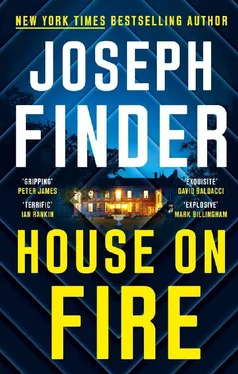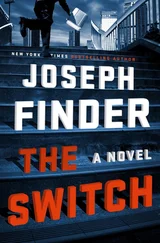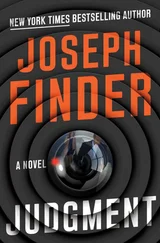My flashlight beam raked the walls of the study, the bookshelves, looking for cleverly built-in cabinetry. Lines in the wood that looked wrong. Seams. But I found nothing. Just books. The floor was covered in an antique-looking Aubusson carpet. The windows had recently been fitted with alarm contacts.
I noticed a door that I remembered from the plans led to a bathroom. That was worth checking out. I opened the door, saw a narrow space. An old-fashioned toilet with a pull-chain water closet above, black and white tiles on the floor, subway tiles on the walls. An old pedestal sink. All probably original to the house.
And it had windows that opened to the outside. I entered the bathroom, inspected the windows, saw no alarm contacts. They hadn’t bothered to alarm the bathroom window. Had I known this, I could have sneaked in that way, from outside, avoiding the alarm entirely.
Then a faint sound came from the hallway.
The sound of a door closing.
Maggie and I looked at each other. We couldn’t really see each other’s eyes, but we both knew what to do. We immediately dropped to the floor, scuttled across the carpet, and squatted down behind the biggest pieces of furniture we could find — the bulky Chesterfield armchairs — flattening ourselves on the floor. Staying out of sight lines in case someone entered the study.
Breathing slowly, I calmed myself and waited for the study door to open.
Conrad Kimball was a light sleeper. Maybe he was a night owl. If he entered the room and switched on the lights, we were both well and truly screwed.
Maybe he was looking for something. Maybe he forgot something.
Maybe Maggie’s intel was bad and a pressure-sensitive silent alarm under the Aubusson had alerted him.
Breathing through my nostrils, I once again managed to steady my pulse. I waited to be discovered.
After all, I was staging a break-in from within the target’s house. The target being a highly suspicious man. Who had at least three outsiders as houseguests: Maggie, me, and Paul’s brilliant Moroccan girlfriend.
I found myself staring at the carpet, at the wooden baseboard. Once my eyes had acclimated to the dark, I could see an odd, misplaced seam in the polished cherrywood baseboard molding. I shone the flashlight on it, pulsed it on and off, and confirmed that there was a vertical seam where — given the high-end craftsmanship that went into building this house, the uninterrupted length of the boards — there shouldn’t be.
A repair? Possibly, but not likely.
So while I listened for the door to open, I crawled across the carpet on my hands and knees and drew closer to the errant seam. I felt it, touched the baseboard, hoping for something like a spring-loaded touch-latch that would open some hidden compartment in the bookcase. I was thinking of a kick panel that might unlock a hidden door. But nothing clicked or moved. I looked more closely, searching for telltale traces of dust that might indicate an air leak from an adjoining room, due to temperature differentials or pressure changes. But I saw none.
I waited for a few more seconds, perfectly still. The door to the study didn’t open.
No one walked in or walked by.
A false alarm. A servant using the bathroom, maybe. No one was coming.
I caught Maggie’s eye and decided to stand. I saw nobody. I thought about the blueprints of the study I’d examined. I distinctly remembered seeing a large closet in the plans, but there didn’t appear to be one here anymore.
So I took out a tiny infrared thermal camera and attached it to my cell phone. I focused on the bookshelves and saw a spill of blue at the baseboard molding, about two or three feet wide.
The blue indicated cold air.
That told me that behind the wall of books was an unheated space; the closet that used to be here had been walled over.
Or converted into a safe room but covered with a bookcase to conceal its entrance. I began testing each shelf, pressing here and there, looking for a spring latch. Maggie got to her feet, saw what I was doing, and started testing the risers, the vertical boards that comprised the bookcases, while I tested the horizontal boards. But nothing clicked. Nothing moved.
Maybe you had to pull a certain book. I’d seen that trick before. Mostly in movies, but occasionally in real life, inspired by the movies. But nothing popped open.
Until Maggie touched the edge of a lower shelf a few inches off the ground and something gave way. A thud, and then a section of shelves jutted open. The shelves were bolted to a metal door. I grasped the edge of the heavy door — heavy because of all the books, plus it was steel — and pulled it open.
The safe room.
Lined with filing cabinets.
She smiled at me. “We’re in,” she said.
We were standing in a small white-painted steel room with a steel floor and rows of gray steel filing cabinets lining two of the walls, narrowing the space where you could stand. Overhead lighting had come on as soon as we entered. I could tell this safe room had been assembled from prefab steel panels, built to a standard size. This one was probably eight by ten. On the back wall were a few shelves. I saw jewelry boxes with pearl necklaces and diamond brooches and other costly items like that, laid out on black velvet. On display like a jewelry store. Natalya’s stash, no doubt.
“Jesus,” she breathed.
But Maggie wasn’t looking at the jewelry. She was focused on the file cabinets.
I pulled the bookshelf-door behind us closed. It clicked shut. Somewhere a ventilation fan began to whirr faintly. I’m not claustrophobic, but this was a small space. It was built to house files and jewelry, not really as a panic room, where the family could hide out in case of an intrusion. It was too cramped to hold more than a couple of people, and there were no visible supplies.
“Leave the door open,” Maggie said.
“Why?”
“I want to hear noises.”
“Fair enough,” I said, and pushed the door open. The vent fan went off.
I said in a low voice, “We’re probably looking for different things. But we can help each other. So what are you looking for?”
This time she didn’t hold back. “His new will. The kids are afraid they’re getting written out and Natalya’s getting written in. They think she’s manipulating Conrad, that she’s all about the Benjamins. What about you?”
“There was a drug trial done on Oxydone years ago. Found that the drug was dangerously addictive in humans and warned against marketing it. That trial was buried, but the files on it are probably somewhere in here.”
“Always thought that was just a rumor.”
“What?”
“That they had proof how addictive it was but somehow the FDA got paid off or something.”
“All I know is there’s a file, and it’s here somewhere.”
She tugged at a steel cabinet labeled legal, but the drawers were locked. I pulled at the one right in front of me, marked family, and that too was locked.
Then I found a cabinet labeled OXYDONE: EARLY DEVELOPMENT.
“You got a pick set?” she said.
“Of course.”
I took out my leather shaving kit and removed a flat pick with a hook on it. I did the gentlemanly thing and turned to the Legal cabinet first, the one Maggie was interested in. It was a four-pin file cabinet lock. It couldn’t have been easier. I pushed in, then pushed down, and the lock popped out. She pulled at the top drawer, and it opened.
“You’re good,” she said. “I forgot how good.”
“Learned from the best.” I had no doubt she knew how to pick locks too — she’d probably taken the government course “Defense Against Methods of Entry,” a series of classes on how to break into places. I’d taken such a course, though by then I already knew how to pick locks, courtesy of a repo man I once met at Norman Lang Motors in Malden, Mass. That’s where I used to hang out a lot with my friend whose dad owned it.
Читать дальше












